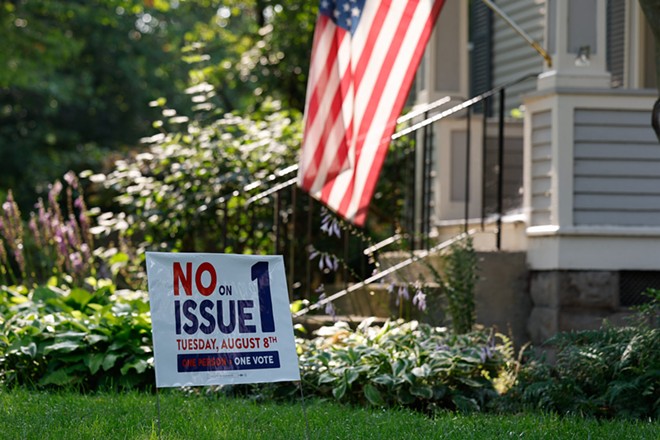
Only white men would be able to enlist in the Ohio National Guard.
Columbus, Cincinnati, Cleveland and Toledo wouldn’t have casinos.
Ohio’s governor wouldn’t have term limits.
Ohioans would only have the option of straight-ticket voting at the polls.
These are just some of the amendments to the Ohio constitution that passed, but received less than 60% of votes — the new threshold proposed by Issue 1.
Since 1913, Ohio has had 227 proposed amendments and 127 of them have passed, but 49 of those approved amendments received less than 60% of votes.
“Clearly, Ohio would be a different place if you had 60% in place,” said Catherine Turcer, executive director of Common Cause Ohio.
Issue 1
Tuesday’s Special Election on Issue 1 would make it harder to amend the Ohio Constitution by requiring future amendments to be approved by 60% of voters instead of the simple majority that is currently needed.
Proposed amendments that get more than 60% of the votes usually have the support of both parties and don’t have any organized opposition, said Mike Curtin, a former democratic member of the Ohio House of Representatives from 2013 to 2016. He is also a retired editor and associate publisher of The Columbus Dispatch.
Issue 1 would also make it tougher to get an issue on the ballot in the first place. Currently, initiatives need signatures from 44 counties, but Issue 1 would double that — requiring signatures from all 88 Ohio counties.
“This is appalling what they’re trying to do,” Curtin said. “This, in my view, would put a bullet through the head of the initiative process all together.”
Turcer wonders if some amendments to the constitution would have even made it to the ballot with the proposed change to the signature collection requirements.
“Because of how difficult it is to do the signature collection, there might have been some efforts that never took off,” she said. “Issue 1 dilutes voter power and also dilutes grassroots power by making it so much harder to do citizens’ initiative.”
History of Ohio’s Constitution
Ohio’s Constitution, which received 53% of the votes, dates back to 1851 — making it the ninth oldest constitution, Curtin said.
“There’s a lot of archaic language in there,” he said. “It needs to be brought up to date to reflect the modern times from time to time.”
Citizen-led amendments
There have been 71 citizen-led amendments since 1913. 19 of them have passed, but eight of those approved amendments received less than 60% of votes.
These are some of amendments that passed, but received less than 60% of the votes:
Home rule power for liquor sales — 50.5% (1914).10-mill limit on unvoted real estate taxes —59.6% (1933).
Home rule for counties — 53.2% (1933).
Eliminate straight-ticketing voting — 57.3% (1949).
Raise the state minimum wage — 56.6% (2006).
Allow a casino in Columbus, Cleveland, Cincinnati and Toledo — 52.9% (2009).
These are some of the amendments that passed and received 60% or more of the votes:
Prohibit sales tax on food for consumption off premise — 68.7% (1936).Allow someone to vote if they are registered for 30 days — 61.5% (1977).
Term limits for state senators and representatives — 68.3% (1992).
A valid marriage in Ohio is only between one man and one woman — 61.7% (2004).
The United States Supreme Court legalized gay marriage in 2015. Freedom to choose healthcare — 65.5% (2011).
Rights for crime victims — 82.5% (2017).
General Assembly amendments
Ohio lawmakers have proposed 156 amendments to Ohio’s constitution since 1913. 108 have passed, but 41 of those amendments received less than 60% of the vote.
These are a handful of amendments that passed, but received less than 60% of the votes:
Deleting the words “white male” from voter qualifications — 55.9% (1923).6-year term for probate judges — 55.2% (1947).
Create a State Board of Education with the power to appoint a Superintendent of Public Instruction — 56.8% (1953).
Getting rid of the word “white” when it comes to qualifications of males to serve in the Ohio National Guard, racially integrating the Ohio National Guard — 58.1% (1953).
4-year terms for the governor, lieutenant governor, attorney general, and secretary of state. It also limits the governor to two terms — 55.5% (1954).
4-year terms for State senators — 57.3% (1956).
Allow women to serve in the Ohio National Guard and widen the age range to those between 17-67 years old — 50.1% (1961).
Blocked special interests from using constitutional amendments to create monopolies — 51.5% (2015).
These are some of the amendments that passed and received 60% or more of the votes:
Repeal statewide prohibition — 68.3% (1933).Permit temporary or substitute judges in the Supreme Court — 70.0% (1944).
Women can run for office — 68.5% (1953).
Allow new Ohio residents to vote for President and Vice President — 61.9% (1957).
Authorize the state lottery —64.0% (1973).
Voters can elect delegates to national party conventions — 64.6% (1975).
Permit state to finance or assist local governments to improve roads, water, sewer and waste collection and treatment facilities — 70.8% (1987).
Protect rights of crime victims — 77.6% (1994).
Denial of bail to persons charged with certain felonies — 72.9% (1997).
The amendments to the Ohio National Guard are good examples of why it’s important to be able to amend the Ohio constitution, Curtin said.
“A state constitution must be able to change with the times,” he said. “We would have still struggled to find a legal way for Blacks or women to serve in the guard.”
1912 Constitutional Convention
During the Ohio Constitutional Convention of 1912, there were 42 proposed amendments and 34 amendments passed, but 19 passed with less than 60% of the votes.
These are a few of the amendments that passed, but received less than 60% of the votes:
Adopt a system of civil service — 59.9% Municipal Home Rule — 58.3% Initiative and Referendum — 57.4% Common pleas judges for each county — 57.4%These are a couple of the amendments that passed and received 60% or more of the votes:
Provide for workmen’s compensation system — 60.2% Abolish prison contact labor — 60.7%Bond issues
If Issue 1 passes next week, Curtin and Turcer worry Ohio will have a hard time passing bond issues on future ballots.
“With a 60% passage requirement in place, the state would have a much much tougher time getting bond issues approved and therefore economic development would be threatened,” Curtin said.
In 1851, the Ohio Constitution imposed a $750,000 limit on debt the state can take on without a public vote.
There have been 18 proposed bond issues since 1980, and 12 have passed with a simple majority. Of those 12, eight got at least 60% of the votes.
Jobs and economic growth — 54.1% (2005).Environmental conservation — 57.4% (2000).
Low-cost housing assistance — 52.9% (1990).
Low-cost housing assistance — 57.3% (1982).
“A constitution as old as ours must be a living document,” Curtin said. “A 60% passage threshold would have all sorts of unforeseen consequences down the road.”
Originally published by the Ohio Capital Journal. Republished here with permission.









